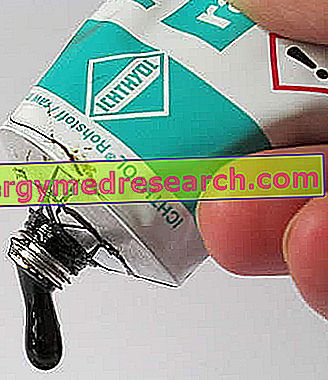Generality
With the term ichthyol, generally, we want to indicate a particular compound of dense consistency and rich in sulfur, which corresponds to the ammonium salt of the sulfoittiolico acid ( sulfoittiolato ammonium ). Often, this salt is also called " ictammol ".

Medicinal Itiolo tube. Image from wikipedia.org
The ichthyol is obtained through the dry distillation of bituminous schists (particular types of sedimentary rocks), containing residues of fish and marine fossil animals.
This compound is attributed keratoplastic, antiseptic, antiseborroic, resolving, anti-inflammatory and decongestant properties.
Idiol-based preparations are available both for human use and for veterinary use.
Examples of medicinal specialties containing ammonium sulfoittiolato
- Ittiolo®
- Ictammolo®
Therapeutic indications
The use of ichthyosis is indicated for the treatment of:
- furunculosis;
- Superficial abscesses and ulcerations of the skin;
- Inflammations of the skin;
- Minor skin infections;
- Inflammations of the sweat glands.
Warnings
The ichthy must absolutely not be applied on or near mucous membranes and eyes.
Due to the side effects that could occur, it is necessary to avoid exposure to UV rays and sunlight following the application of ichthyol.
Prolonged use may cause irritation and / or sensitization phenomena. Should this happen, it is necessary to stop the therapy immediately and contact the doctor, who will decide what to do.
Care should be taken when using ichthyol, as this medicinal product is incompatible with acids, alkalis, iron salts and alkaloids.
Interactions with other drugs
At present, there are no data available on any drug interactions that could occur between ichthy and other drugs.
However, before starting the treatment with ichthyol - also considering the chemical incompatibilities of the product with acids, alkalis, alkaloids and iron salts - it is always good to inform your doctor if you are taking, or have recently been taken, drugs of any kind, including non-prescription drugs, herbal products and homeopathic remedies.
Side effects
The ichthyol, like any other drug, can cause side effects, although not all patients get them.
The type of adverse effects and the intensity with which they occur vary from individual to individual, depending on the sensitivity of each person to the drug itself.
The side effects that may occur following the use of ichthyosis occur mainly in the skin and subcutaneous tissue and consist of:
- Burning;
- Skin irritation;
- Dermatitis;
- Hypersensitivity reactions.
Overdose
In case of ichthyol overdose, irritative phenomena may occur on the skin and mucous membranes.
Therefore, if it is suspected that itolite overdoses, it is necessary to contact the doctor immediately or go to the nearest hospital.
Action mechanism
As mentioned, keratoplastic, antiseptic, antiseborroic and anti-inflammatory properties are attributed to the ichthyosis, mainly due to the sulfur activity contained in it.
Not by chance, precisely because of these properties, sulfur is widely used in the dermatological field in the treatment of oily and acneic skin.
Method of use and dosage
The ichthyosis is available as an ointment. Generally, it is advisable to apply an adequate amount of product directly to the area of skin affected by the disorder and to cover it all with gauze.
It is usually recommended to use the ichthyol based ointment from two to three times a day.
Pregnancy and breastfeeding
Since there are no specific studies providing indications about the effects of using ichthyol in pregnancy and lactation, pregnant women and breastfeeding mothers should only use this drug in cases of actual need and only under the strict supervision of the doctor.
In any case, before starting the ichthyol-based treatment, this category of patients must absolutely seek the advice of their doctor.
Contraindications
The use of ichthyosis is contraindicated in case of hypersensitivity ascertained by the same ichthyol.



